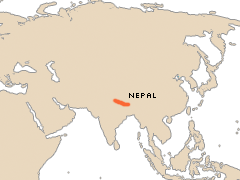
How do we know
The effects of the vitamin A program on child mortality were analyzed in a peer-reviewed journal article. This ex-post study of Demographic and Health Survey data from 2001 took advantage of the fact that districts were incorporated into the program at 6-month intervals, creating natural treatment and control groups for comparison. After controlling for potentially confounding factors such as poverty, disease prevalence, and mother's education, logistic regressions demonstrated that 100 percent community-level vitamin A coverage between 1995 and 2000, relative to no coverage, reduced the under-5 child mortality old by about half.Downloads
- Read the entire case study
(PDF | 113 K)
External Links
- Learn more about vitamin A deficiency and supplementation
- Watch a video on the nationwide vitamin A campaign in Nepal
- Examine the country health profile of Nepal
- Read an analysis of the effects of vitamin A supplementation in Nepal based on national survey data
- Read about the important role of female community health volunteers in the success of health programs in Nepal (pdf)
- Take an in-depth look at the vitamin A program in Jumla, Nepal (pdf)
Health Condition: Vitamin A deficiency affects approximately 21 percent of the developing world's preschool-aged children and leads to the deaths of over 800,000 women and children each year. Because it compromises the immune system, vitamin A deficiency is estimated to be responsible for nearly one-fourth of global child mortality from measles, diarrhea and malaria and for a fifth of all-cause maternal mortality. In the 1990s, 2-8 percent of preschool-aged Nepali children experienced severe vitamin A deficiency, or xerophthalmia, associated with blindness and risk of child death.
Intervention or Program: In 1993, the government of Nepal initiated the National Vitamin A Programme (NVAP) with the support of UNICEF, USAID, and local researchers and NGOs. NVAP aimed to reduce child mortality and morbidity related to vitamin A deficiency by providing twice-yearly supplements of vitamin A capsules to children in priority districts; treating xerophthalmia, severe malnutrition, prolonged diarrhea and measles; and encouraging dietary intake of vitamin A and breastfeeding. A large cadre of women who served as community-based volunteers was integral to the rapid expansion of the program to Nepal’s 75 districts.
Impact: NVAP prevents blindness in approximately 2,000 children each year, and was found to reduce under-five mortality in Nepal by about half between 1995 and 2000.
Cost and Cost-Effectiveness: The cost of delivering two rounds of vitamin A per year was approximately $1.25 per child covered. With an estimated cost of $327 –$397 per death averted and $11-12 per disability-adjusted life year (DALY) gained, NVAP is considered highly cost-effective.

